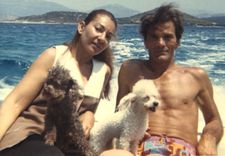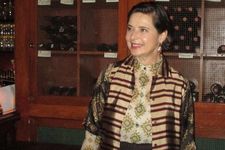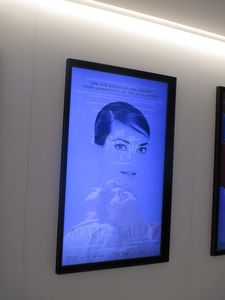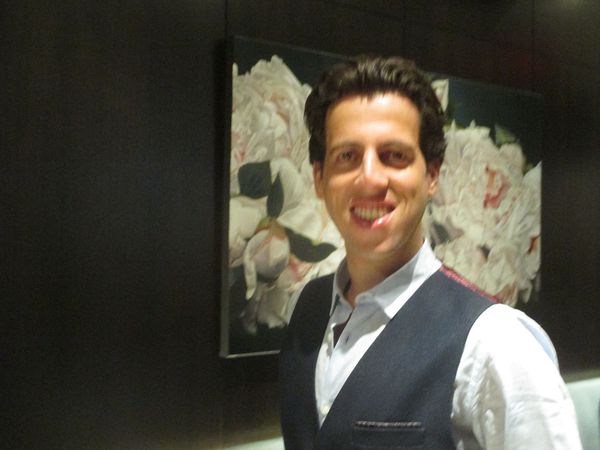In the second half of my conversation with Tom Volf, the director of Maria By Callas and author of Maria By Callas: In Her Own Words, the two sides of the coin of Maria Callas were explored. Callas working on Pier Paolo Pasolini's Medea, why her favourite role is Norma, calling her toy poodles "my babies", Lisa Immordino Vreeland's Love, Cecil, Yorgos Lanthimos' The Favourite, and Kevyn Aucoin transforming Isabella Rossellini into Maria Callas as seen in Tiffany Bartok's Larger Than Life: The Kevyn Aucoin Story, all came up, taking us into a kind of time travel back to the golden age.
 |
| Maria Callas with her poodles and Pier Paolo Pasolini who directed her in Medea: "In her letters she used to call them 'my babies'." |
Maria Callas died in 1977, so it is recordings from radio and clips from television interviews, including with David Frost, Edward R. Murrow, and Barbara Walters, that help us learn about her, as much as she allows. A sheer endless parade of airport arrivals, dressed to the nines, poodle Toy in tow, makes it easy to drift momentarily into a dreamworld of mid-century notoriety, with Callas's voice hypnotizing us into something that never really existed.
Tom Volf's Maria By Callas is a beautiful film that enchants without relying on duplicity and it might trigger questions such as these: How do you serve music with humility? Who really is Madame Butterfly? What happens when you have no childhood? When Callas speaks about the fact that she would have liked to have had children and that she feels she was forced into her career, first by her mother and then by her husband, Giovanni Battista Meneghini, centuries of gender expectations fly open and reveal a wound of uncertainty.
Anne-Katrin Titze: In the documentary [Larger Than Life: The Kevyn Aucoin Story] about make-up artist Kevyn Aucoin, there is a scene where Isabella Rossellini is talking about being made up as Maria Callas.
Their mouths are totally different, but the style and expressiveness is unmistakable. In the context of the Pasolini Medea film, there is an interesting quote where Callas says that she was trying to find "the human parts" of Medea. Always.
Tom Volf: She would always try to find the human part in each of her roles. I think that's what made her interpretation so unique, so extraordinary. She would reach for what resonated in her as a woman, her own life experiences and struggles and she would connect that, almost like Actors Studio.
 |
| Kevyn Aucoin transformed Isabella Rossellini into Maria Callas as seen in Tiffany Bartok's Larger Than Life: The Kevyn Aucoin Story Photo: Anne-Katrin Titze |
She would connect whatever she had in herself with the character, with the music and the singing and the technique and the score and all of that but with the acting and interpretation. Suddenly these great heroines of tragedy became alive.
AKT: Came down to earth from the heavens.
TV: Definitely. And the emotion of the characters is conveyed to us, we can feel it in ourselves, through her own emotions that are piercing through the character from her own heart and soul.
AKT: Let's talk about her poodles. Toy is the name of her first, who looks frightened at times.
TV: Yes, in the crowd!
AKT: They are much more than accessories for her.
TV: In her letters she used to call them "my babies."
AKT: Have you seen The Favourite, the New York Film Festival Opening Night selection?
TV: No, I haven't.
AKT: Watch it and remember "my babies." In Rome in 1958, they called Callas a "tigress" whereas she herself says she was terrified. The two sides of the coin again.
TV: Maria and Callas. Everyone thought of Callas being a tigress because she was so fierce on stage.
 |
| Maria Callas with Luchino Visconti who directed her in La Traviata at La Scala: "She would always try to find the human part in each of her roles." |
AKT: And you show that it really is her trying to get through this.
TV: Of course, it's exactly that moment where her reputation and who she truly was were in complete opposition. Because she was vulnerable, she could be frail. She looked strong, though she was not. She often compared herself to her favourite character, which was Norma, the one she interpreted the most on stage, over a hundred times, I think.
She would say, this is a character who looks so fierce, who is a big priestess, has a lot of influence and appeared to be very strong. But behind the appearance there is a very vulnerable woman that ends up sacrificing herself for the man she loves. A man who loves another woman. There's the parallel with her own life.
AKT: With Jackie and Onassis. And she had to find out through the papers that he married her! A tiny detail I wanted to ask you about, in the footage of the people sleeping outside Carnegie Hall to get tickets for her performance ...
TV: They're so young. Teenagers!
AKT: The poster behind them says: Design and Costumes by Cecil Beaton [the production title is not in the frame].
TV: That was another production, that was not the Tosca production.
AKT: I was wondering. Did you see the Cecil Beaton documentary Love, Cecil by Lisa Immordino Vreeland?
 |
| Maria By Callas poster transforming into Call Me By Your Name at Sony Pictures Classics Photo: Anne-Katrin Titze |
TV: I did. You know, Beaton actually took a lot of pictures of Callas. They had photo shoots together. It's so interesting to notice all those people who were part of the same era. All the people you see in the film. Elizabeth Taylor, Churchill.
AKT: Grace Kelly, Jean Cocteau.
TV: They were all part of the same time - the golden age.
AKT: After watching Maria By Callas, I actually felt a bit disoriented getting on the subway. Your film felt like time travel as well.
TV: I love you saying that! This is exactly how I tried to make the film for the theatre. The cinema is that unique place when the door closes, the lights go down and you're in a time travel machine. Why I wanted to make the film 100% out of archives and to build it as a story that is so immersive, is to time travel. Because it's a world that doesn't exist anymore.
Read what Tom Volf had to say on the split between Maria and Callas, her unhappy childhood, Jackie Kennedy and Aristotle Onassis, and finding the right tempo for Maria By Callas.
Maria By Callas is in cinemas in the US and is eligible to be Oscar shortlisted for the 91st Academy Awards.






















